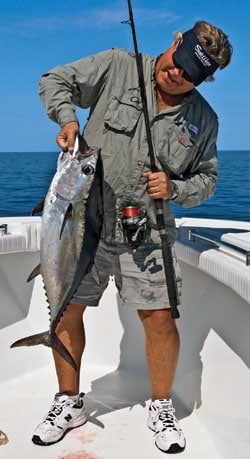
Captain Robert “RT” Trosset stared intently at his video sounder as we idled toward the stern of an anchored shrimp boat some 45 miles northwest of Key West in the Gulf of Mexico. The shrimpers had trawled all night and recently finished separating the harvested shrimp from the other critters scooped up in the giant nets – what scientists call “bycatch” but fishermen call “shrimp boat trash.”
The shrimpers shovel the trash overboard around daybreak, and predators move in to feast upon the thousands of small fish and crustaceans that are thus disposed of. This creates an incredible fishing opportunity for blackfin tuna, little tunny (what we Floridians call “bonito”) and cobia. The trash makes it all happen, and so each day starts with the purchase of a bag or two from an anchored boat. The shrimpers know that fishermen want the trash to attract tuna, so they save some to sell in the hopes of picking up an extra buck or two.
Trosset had purchased two large bags of trash from one of the shrimpers the day before, so now we searched for the fish. As we approached the stern of the first boat, a large red orb appeared on the video screen, and Trosset said, “We’ve got company.” He turned off the engines on his 34-foot Yellowfin, Spindrift, and began throwing a few pieces of the trash overboard to see what might show up from below.
It didn’t take long to find out. Hordes of little tunny swarmed around the boat, their telltale green backs flashing in the clear Gulf water. We only spent a few minutes there and ultimately decided that we needed to move; bonitos are fine sport on light tackle, but we had come in search of blackfin, and they simply weren’t appearing beneath this particular shrimp boat.
Invest Bait Wisely
“We don’t want to waste our bait here,” Trosset said. “You don’t want to invest all of your bait on bonitos. You need 60 to 70 pounds of trash for bait, and you can go through it quickly if you’re not careful.” Fortunately, seven more shrimp boats lay at anchor, spread out over several square miles of the Gulf. We moved to the closest one and repeated the process.
This time, our drift and Trosset’s chumming produced bonitos at first, but then a large black shape came streaking through the chum. “That’s what we’re looking for,” Trosset said, and we set up to fish. My wife, Poppy, and I each grabbed stout spinning rods rigged with 30-pound braided line and 30-pound fluorocarbon leader tied to circle hooks. We baited with dead fish, carefully selected from the bag of trash, and awaited instructions.
“The key to catching blackfins and not bonitos is to throw just enough trash to keep them interested without getting the bonitos too fired up,” Trosset explained. “If the bonitos get into a feeding frenzy, they will crowd out the blackfins and you’ll never get one.” He went on to explain that as we drifted farther from the shrimp boat, we would draw the fish away with us as they followed the chummed trash. With just the right amount of trash tossed overboard, the bonitos would eventually fall off, and the blackfins would remain.
When we began seeing more black backs than green ones in the water, Poppy and I cast our baits and stared into the depths below to see what would come. I hooked up first, a large bonito that came streaking out from under the boat. My reflexes were too slow to get the bait away from the fish as I saw it coming, but the 15-pounder put up a great fight and was released quickly.
Tuna Time
Poppy did better: A large black shape engulfed her bait and headed straight down as the rod bent over hard. “That’s a nice fish,” Trosset said, a fact made obvious by the amount of braid screaming off the reel. Blackfin put up a terrific fight, and Poppy strained to lift the fish from the depths, but she soon had it boat-side, where Trosset gaffed it and swung it aboard. Our first blackfin of the day, a beauty that weighed in at 31 pounds! Fifteen-pound bonito are fun, but a 31-pound blackfin is awesome, and tasty too.
We repeated the process again and again during a hard morning of fishing, working from one shrimp boat to another, and we ended up catching nine blackfin, the smallest of which weighed 24 pounds. We also caught and released a dozen or more bonitos, including a few on fly rods. This light-tackle action went on nonstop until shortly after noon, when the fish faded away and we could no longer raise them. Just as well: A morning of pulling on strong fighters like these is enough.
Shrimpers move to the southern Gulf in late winter, north of Key West, and spring finds the tunas following them. Find the anchored shrimpers in May, and you’ll undoubtedly find plenty of light-tackle action.
Next: Five Can’t-Miss Tips
Here are five tips to help avoid less-desirable species and catch more blackfin in this unique and fascinating fishery.
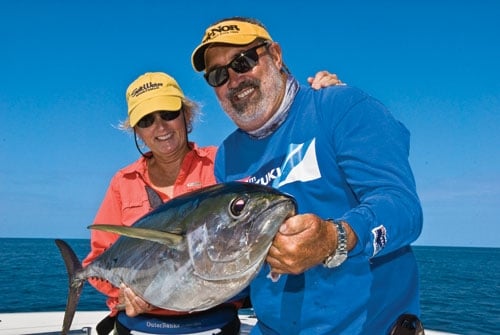
1. Fish the Edge: When you get the fish chummed up around your boat, you want to target blackfin and not bonito, so fish your baits around the edge of the schooling fish, not in the middle of them. “Keep your baits away from the mass of fish so you can see what’s coming,” Capt. “RT” Trosset advises. If you see a bonito coming for the bait, move it and wait for the blackfin. The bonito are more likely to eat baits fished closer to them, but the blackfin seem more willing to move out to the edge of the school to take a bait.
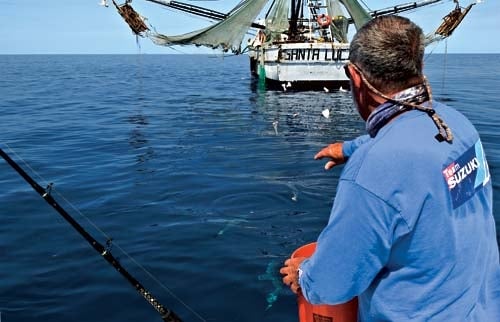
2. See What You’ve Got: “When you pull up behind the shrimp boat, drop a lot of chum initially to see what’s there,” Trosset says. “If there are more tunas than bonitos, slow your rate of chumming as you drift farther from the shrimp boat. This will calm the bonitos down, causing them to meander instead of feeding in a frenzy, letting you target the blackfin.” Of course, if you see only bonitos come up in your initial heavy dose of chum, save the trash and move on to another boat. Don’t invest your trash in bonitos.
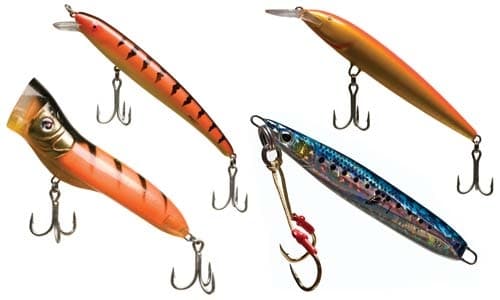
3. Try Artificials: This is a perfect situation for jigging, and heavy metal jigs like butterfly jigs work great. “Use a heavy metal jig, but don’t strike the bite on the way down,” Trosset says. “You want to use a jig weighing 2 ounces or more, and get it to the bottom. Then, just jig it up 10 or 15 feet, not all the way up. The shrimpers are usually in 80 to 100 feet of water, and you’re more likely to hook a blackfin if you leave the jig deep.”
Another trick involves large floating plugs like Rapalas or Bombers. “For some reason, they like orange plugs,” Trosset explained. “Throw a 7-inch or larger plug out to the edge of the school of fish and just let it sit there; don’t move it at all. The tunas will whack the crap out of it.”
Of course, this style of fishing also lends itself perfectly to fly-casting and virtually any other type of casting tackle; it’s just that with general artificial fishing you will inevitably hook lots of bonitos in addition to the blackfin. The specialized techniques mentioned here help you target blackfin exclusively.
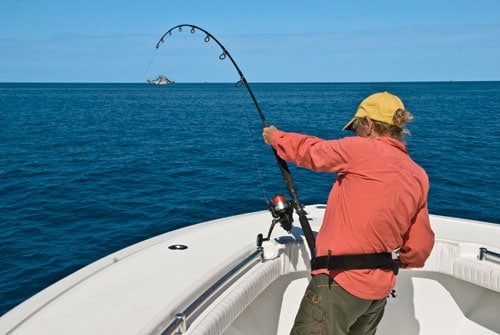
4. Use Large Fish for Bait: Shrimp boat trash contains all sorts of dead animals, including crabs, various species of unmarketable shrimp, and lots of different species of fish. A $20 bill will get you all you need, but be picky about what you put on your hook. “The more fish in the trash, the better,” Trosset said. “Try finding bigger fish for hook baits, fish that weigh at least a half-pound or more. Sometimes the bonito will lay off the bigger fish, but the blackfin will eat them, no problem.” He also says that you can toss out large, nose-hooked dead mullet or even a ballyhoo. Your hook bait doesn’t necessarily have to come from the trash. If you can find puffer fish or a larger lane snapper in the trash, use those; blackfin eat them like they’re candy, and bonito will usually leave them alone.
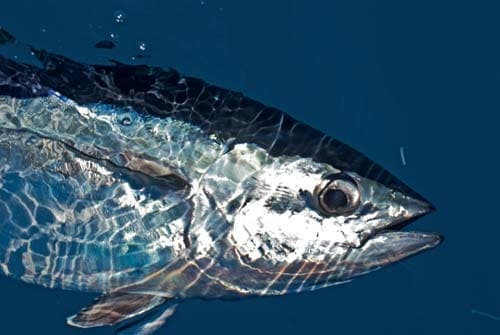
5. Keep One on the Line: Like dolphin, blackfin will follow a hooked fish, so keep one on the line and in the water until someone hooks another one. By doing so, you keep the feeding tuna beneath your boat while having to expend very little chum, enabling you to keep targeting them even after you’ve drifted far away from the anchored shrimp boat where you started. And in a center-console boat, you can move to the bow, away from the chumming activity at the stern, leading the hooked blackfin away from the school of bonito and hopefully drawing the other blackfin with it. And while you’re catching all those tuna, keep an eye out for cobia; they love trash too, and it’s common to have a huge fish appear from beneath your boat, usually at the worst possible time. By being ready, you increase your chances of adding a fat cobia to the tuna in your fish box.
Next: Trip Planner >>
Trip Planner
What: Blackfin tuna
Where: Key West, Florida, although these techniques can be applied just about anywhere that shrimp boats operate and have bycatch available.
When: Spring; May is best.
Who: Fishing the shrimp boats is totally doable in your own boat. If you want to have at it on your own, here’s a list of local marinas that will get you on your way. If you’d prefer to book a professional charter, take your pick from the list below of Key West captains.
A&B; Marina
305-294-2535
www.aandbmarina.com
City Marina at Garrison Bight; public boat rampwith trailer storage.
305-809-3981
Hurricane Hole Marina
305-294-8025
www.hurricaneholekeywest.com
Oceanside Marina
305-294-4676
Capt. Robert “RT” Trosset
305-797-5693
Capt. Ryan Muntin
305-766-5655
Capt. Rob Nevius
305-797-4267
Capt. Greg Sherertz
305-797-5601









